
News of the fire of the basilica of St. Paul's from Roman newspaper "Diario di Roma"
The terrible fire that broke out on the roof of St Paul’s Basilica on the night of 15 July 1823 was major news in journals and newspapers of the day. The first paper to cover the event, which was subsequently picked up by foreign papers, was the Diario di Roma, known commonly as Chracas, after the name of the family that printed it. The Chracas’ family paper first appeared in 1716 for the specific purpose of providing news on the Hungarian War (Diario d’Ungheria). It changed its name a number of times over the years (Diario ordinario, Diario di Roma), as well as its format (pocket-sized, a limited number of pages, and many pages); it also altered its stance as it passed through the hands of various family members. Well into the 1800s, it published brief and extended news coverage of major political, religious and military events in Italy and abroad, serving as an incredibly valuable source of news.
Diario di Roma, n. 56, 16 July 1823